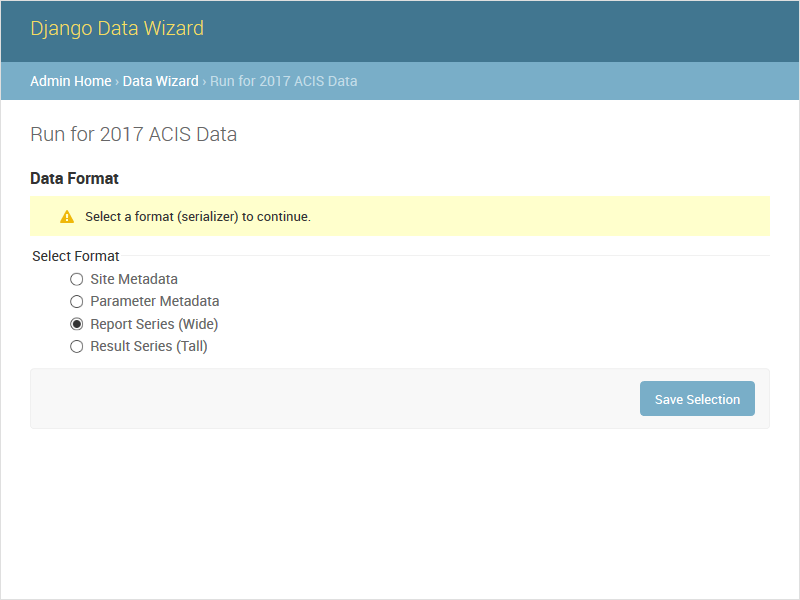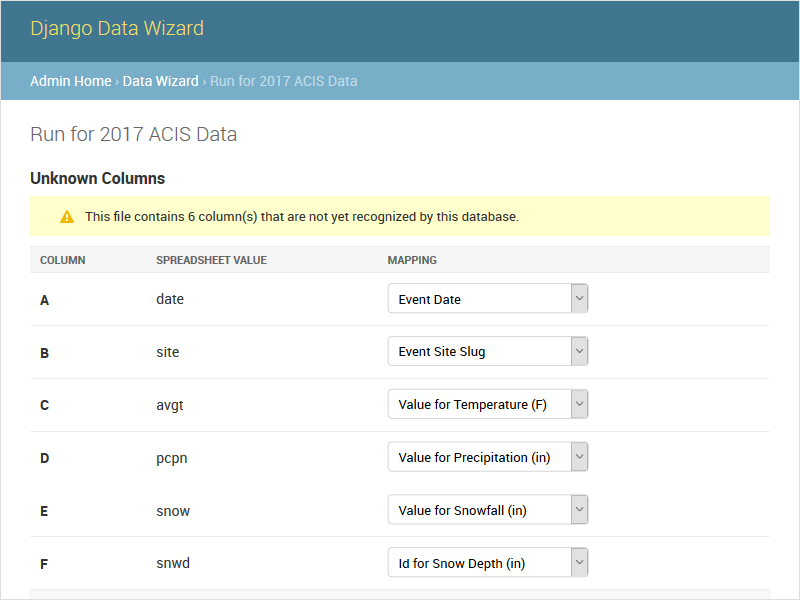vera is the reference implementation of the Entity-Record-Attribute-Value (ERAV) data model. ERAV is an extension to Entity-Attribute-Value (EAV) that adds support for maintaining multi-faceted provenance metadata for an entity 1.
The implementation of ERAV provided by vera is optimized for storing and tracking changes to time series data as it is exchanged between disparate technical platforms (e.g. mobile devices, Excel spreadsheets, and third-party databases). In this context, ERAV can be interpreted to mean Event-Report-Attribute-Value, as it represents a series of events being described by the reports submitted about them by various contributors in e.g. an environmental monitoring or citizen science project.
# Recommended: create virtual environment
# python3 -m venv venv
# . venv/bin/activate
pip install veravera is an extension to the wq framework. See https://github.com/wq/vera to report any issues.
The core of vera is a collection of Django models that describe the various components of the ERAV data model.
There are four primary models (ERAV) and three auxilary models, for a total of seven models. The mapping from vera models to their ERAV conceptual equivalents is below:
| ERAV equivalent | model | module |
|---|---|---|
| - | Site |
vera.params |
| Entity | Event |
vera.series |
| - | ReportStatus |
vera.params |
| Record | Report |
vera.series |
| Attribute | Parameter |
vera.params |
| Value | Result |
vera.results |
| - | EventResult |
vera.results |
The vera models are all swappable, which means they can be subclassed and extended without breaking the foreign key relationships needed by the ERAV model. The base models are technically split between three modules within vera, but can all be imported from vera.base_models. For example, to customize the Event model, subclass BaseEvent and update your settings.py:
# myapp/models.py
from django.db import models
from vera.base_models import BaseEvent
class Event(BaseEvent):
date = models.DateTimeField()
type = models.CharField()# settings.py
WQ_EVENT_MODEL = "myapp.Event"Note that as with any swappable model, Django migrations do not expect swappable settings to change after the initial migration. Thus, it is best to leave these settings alone once there is data in the database.
Each of the seven models are described in detail below.
The Site model represents the location where an event occured. It is not strictly a part of the original ERAV definition but is a natural extension. In the default implementation, Site is an IdentifiedModel with latitude and longitude fields.
# myapp/models.py
from django.db import models
from vera.base_models import BaseSite
class Site(BaseSite):
description = models.TextField()# settings.py
WQ_SITE_MODEL = "myapp.Site"All site instances have a valid_events property that returns all of the event instances that contain at least one valid report.
The Event model corresponds to the Entity in the ERAV data model. Event represents a time series of monitoring events. For example, each visit a volunteer makes to an observation site could be called an Event. The Event model does not contain any metadata about the digital record describing the event. This information is in the Report model, discussed below.
At a minimum, an Event instance has a site reference (see below) and an event date, which might be either a date or a full date and time, depending on project needs. The default implementation assumes a date without time. A custom date field and additional attributes can be configured by extending BaseEvent and swapping out Event via the WQ_EVENT_MODEL setting. Note that if Event is swapped out, EventResult should be as well.
To support custom workflows, the list of report statuses is maintained as a separate model, ReportStatus. ReportStatus extends IdentifiedModel with an is_valid boolean indicating whether reports with that status should be considered valid. Additional attributes can be added by extending BaseReportStatus and swapping out ReportStatus via the WQ_REPORTSTATUS_MODEL setting.
In a typical project, the ReportStatus model might contain the following instances:
| slug | name | is_valid |
|---|---|---|
| unverified | Unverified | False |
| verified | Verified | True |
| deleted | Deleted | False |
The Report model corresponds to the Record in the ERAV data model. Report tracks the provenance metadata about the Event, e.g. who entered it, when it was entered, etc. Depending on when and how data is entered, there can be multiple Reports describing the same event. The status of each of these reports is tracked separately.
At a minimum, Report instances have an event attribute, a status attribute (see below), a user attribute, and an entered timestamp. user and entered are set automatically when a report is created via the REST API. Additional attributes can be added by extending BaseReport and swapping out Report via the WQ_REPORT_MODEL setting. Note that the Report model contains only provenance metadata and no information about the event itself - the Event model should contain that information.
In addition to the default manager (objects), Report also has a custom manager, valid_objects that includes only reports with valid statuses. Report instances have a vals property that can be used to retrieve (and set) a dict mapping of parameter names to result values (see below).
In cases where there are more than one valid report for an event, there may be an ambiguity if reports contain contradicting data. In this case the WQ_VALID_REPORT_ORDER setting can be used control which reports are given priority. The default setting is ("-entered", ), which gives priority to the most recently entered reports. (See the CSCW paper for an in depth discussion of conflicting reports).
The Parameter model corresponds to the Attribute in the ERAV data model. Parameter manages the definitions of the data "attributes" (or "characteristics", or "fields") being tracked by the project. By keeping these definitions in a separate table, the project can adapt to new task definitions without needing a developer add columns to the database.
BaseParameter extends IdentifiedModel with is_numeric boolean, and a units definition (which usually only applies to numeric parameters). Additional attributes can be added by extending BaseParameter and swapping out Parameter via the WQ_PARAMETER_MODEL setting.
The Result model corresponds to the Value in the ERAV data model. Result manages the definitions of the data attributes (or characteristics, or fields) being tracked by the project. Result is effectively a many-to-many relationship linking Report and Parameter with a value: e.g. "Report #123 has a Temperature value of 15". Note that Result does not have a foreign key pointing to Event directly - this is a core distinction of the ERAV model.
At a minimum, Result instances have a type (which references Parameter), a report, and value_text and value_numeric fields - usually only one of which is set for a given Result, depending on the is_numeric property of the Parameter. Result instances also contain an empty property to facilitate fast filtering during analysis (see below). Additional attributes and custom behavior can be added by extending BaseResult and swapping out Result via the WQ_RESULT_MODEL setting. Note that if Result is swapped out, EventResult should be as well.
Result instances have a settable value attribute which is internally mapped to the value_text or value_numeric properties depending on the Parameter. Result instances also have an is_empty(val) method which is used to set the empty property. The default implementation counts None, empty strings, and strings containing only whitespace as empty.
The EventResult model is a denormalized table containing data from the "active" results for all valid events. A valid event is simply an event with at least one report with an is_valid ReportStatus. To determine which results are active:
- First, all of the results are collected from all of the valid reports for each event. Only non-empty results are included.
- Next, results are grouped by parameter. There can only be one active result per parameter.
- Within each parameter group, the results are sorted by
Report, using theWQ_VALID_REPORT_ORDERsetting. The first result in each group is the "active" result for that group.
(This is not exactly how the algorithm is implemented, but gives an idea of how it works)
In the simple case, where there is only one valid Report for an event, all of the Result instances from that Report will be counted as active. In more complex situations, some Result instances might be occluded.
Since this algorithm can be computationally expensive, the results are stored in the EventResult model for fast retrieval. The EventResult model should never be modified directly, as it is updated automatically whenever an Event, Report, or Result is updated.
The EventResult model contains an event attribute, a result attribute, and all of the fields from both Event and Result (prefixed with the source model name). The full set of fields for the default EventResult model is event, result, event_site, event_date, result_type, result_report, result_value_numeric, result_value_text, and result_empty.
Whenever Event or Result are swapped out, EventResult should be swapped as well. The create_eventresult_model() function can be used to generate an EventResult class without needing to manually duplicate all of the field definitions.
# myapp/models.py
from django.db import models
from vera.base_models import BaseEvent, Result
class Event(BaseEvent):
date = models.DateTimeField()
type = models.CharField()
EventResult = create_eventresult_model(Event, Result)# settings.py
WQ_EVENT_MODEL = "myapp.Event"
WQ_EVENTRESULT_MODEL = "myapp.EventResult"vera is designed for use with the wq framework, which can automatically generate offline-capable data entry forms for the Site, Parameter, ReportStatus, and Report models. The Event, Result, and EventResult models are not meant to be edited directly, as they are populated when a Report form is submitted. The default report_edit template can be customized for a more compact layout. For example, see the Try WQ report_edit template and the wqxwq report_edit template.
vera includes built-in support for importing data from Excel and other spreadsheet formats via the Django Data Wizard. Four default wizard templates (serializers) are provided, as shown in the screenshot below.
Both the Report Series and Result Series serializers are used to import timeseries data (simultaniously populating the Event, Report, and Result tables). The difference between Report Series and Result Series is that the former assumes parameter names are listed as columns across the top of the spreadsheet (as in the screenshot below), while the latter assumes each row lists a single parameter and a single result.
vera also ships with an EventResultSerializer and views that leverage Django REST Pandas' charting serializers. This makes it possible to quickly generate d3.js charts from the EventResult table via wq/chartapp.js or the underlying modules (wq/chart.js and wq/pandas.js). The provided TimeSeriesView, ScatterView, and BoxPlotView implement identify URL filtering, meaning you can filter by Site and/or Parameter by adding additional slugs to the URL.
For example, with the following URL configuration:
# myproject/urls.py
from vera.results.views import TimeSeriesView
urlpatterns = [
url(r'^data/(?P<ids>[^\.]+)/timeseries$', cls.as_view())
]The following requests would be possible:
| URL Path | Output |
|---|---|
/data/stream1/temp/timeseries |
HTML table and interactive wq/chartapp.js chart showing EventResult values for the Parameter "temp" at the Site "stream1" |
/data/stream1/temp/timeseries.csv |
CSV export of the same |
/data/stream1/lake2/timeseries.csv |
CSV export for all values from Sites "stream1" and "lake2" |
Footnotes
-
Sheppard, S. Andrew, Andrea Wiggins, and Loren Terveen. "Capturing Quality: Retaining Provenance for Curated Volunteer Monitoring Data." In Proceedings of the 17th ACM conference on Computer Supported Cooperative Work & Social Computing (CSCW 2014), pp. 1234-1245. ACM, 2014. ↩












